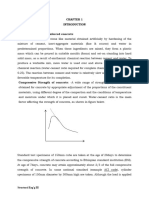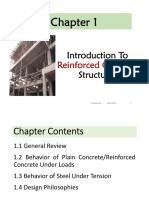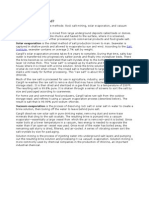1.6.1 Properties of Hardened Concrete (Part II)
1.6.1 Properties of Hardened Concrete (Part II)
Uploaded by
bemd_ali6990Copyright:
Available Formats
1.6.1 Properties of Hardened Concrete (Part II)
1.6.1 Properties of Hardened Concrete (Part II)
Uploaded by
bemd_ali6990Original Title
Copyright
Available Formats
Share this document
Did you find this document useful?
Is this content inappropriate?
Copyright:
Available Formats
1.6.1 Properties of Hardened Concrete (Part II)
1.6.1 Properties of Hardened Concrete (Part II)
Uploaded by
bemd_ali6990Copyright:
Available Formats
Prestressed Concrete Structures
Dr. Amlan K Sengupta and Prof. Devdas Menon
1.6 Concrete (Part II)
This section covers the following topics. Properties of Hardened Concrete (Part II) Properties of Grout Codal Provisions of Concrete
1.6.1 Properties of Hardened Concrete (Part II)
The properties that are discussed are as follows. 1) Stress-strain curves for concrete 2) Creep of concrete 3) Shrinkage of concrete
Stress-strain Curves for Concrete Curve under uniaxial compression The stress versus strain behaviour of concrete under uniaxial compression is initially linear (stress is proportional to strain) and elastic (strain is recovered at unloading). With the generation of micro-cracks, the behaviour becomes nonlinear and inelastic. After the specimen reaches the peak stress, the resisting stress decreases with increase in strain. IS:1343 - 1980 recommends a parabolic characteristic stress-strain curve, proposed by Hognestad, for concrete under uniaxial compression (Figure 3 in the Code).
fc
fc fck
0
Figure 1-6.1 strain curve for concrete
cu c
a) Concrete cube under compression, b) Design compressive stress-
Indian Institute of Technology Madras
Prestressed Concrete Structures
Dr. Amlan K Sengupta and Prof. Devdas Menon
The equation for the design curve is as follows. For c 0
2 fck = fck 2 c - c 0 0
fc = fck Here, fc = compressive stress fck = characteristic compressive strength of cubes c = compressive strain 0 = strain corresponding to fck = 0.002 cu = ultimate compressive strain = 0.0035
(1-6.1) For c < c cu (1-6.2)
From the characteristic curve, the design curve is defined by multiplying the stress with a size factor of 0.67 and dividing the stress by a material safety factor of m = 1.5. The design curve is used in the calculation of ultimate strength. The following sketch shows the two curves.
fc fck
0.447 fck Characteristic curve Design curve
0
Figure 1-6.2
cu
Stress-strain curves for concrete under compression
In the calculation of deflection at service loads, a linear stress-strain curve is assumed up to the allowable stress. This curve is given by the following equation. fc = Ecc (1-6.3)
Note that, the size factor and the material safety factor are not used in the elastic modulus Ec. For high strength concrete (say M100 grade of concrete and above) under uniaxial compression, the ascending and descending branches are steep.
Indian Institute of Technology Madras
Prestressed Concrete Structures
Dr. Amlan K Sengupta and Prof. Devdas Menon
fc fck
Es
Figure 1-6.3
Eci
0 c
Stress-strain curves for high strength concrete under compression
The equation proposed by Thorenfeldt, Tomaxzewicz and Jensen is appropriate for high strength concrete. n c 0 fc = fck nk c n - 1+ 0 The variables in the previous equation are as follows. fc c 0 k n = compressive stress = compressive strain = strain corresponding to fck = 1 for c 0 = 0.67 + (fck / 77.5) for c > 0. The value of k should be greater than 1. = Eci / (Eci Es) Eci = initial modulus Es = secant modulus at fck = fck / 0. The previous equation is applicable for both the ascending and descending branches of the curve. Also, the parameter k models the slope of the descending branch, which increases with the characteristic strength fck. To be precise, the value of 0 can be considered to vary with the compressive strength of concrete. fck = characteristic compressive strength of cubes in N/mm2
(1-6.4)
Indian Institute of Technology Madras
Prestressed Concrete Structures
Dr. Amlan K Sengupta and Prof. Devdas Menon
Curve under uniaxial tension The stress versus strain behaviour of concrete under uniaxial tension is linear elastic initially. Close to cracking nonlinear behaviour is observed.
fc
fc
c
(a) Figure 1-6.4 under tension In calculation of deflections of flexural members at service loads, the nonlinearity is neglected and a linear elastic behaviour fc = Ecc is assumed. In the analysis of ultimate strength, the tensile strength of concrete is usually neglected. (b)
a) Concrete panel under tension, b) Stress-strain curve for concrete
Creep of Concrete Creep of concrete is defined as the increase in deformation with time under constant load. Due to the creep of concrete, the prestress in the tendon is reduced with time. Hence, the study of creep is important in prestressed concrete to calculate the loss in prestress. The creep occurs due to two causes. 1. Rearrangement of hydrated cement paste (especially the layered products) 2. Expulsion of water from voids under load If a concrete specimen is subjected to slow compressive loading, the stress versus strain curve is elongated along the strain axis as compared to the curve for fast loading. This can be explained in terms of creep. If the load is sustained at a level, the increase in strain due to creep will lead to a shift from the fast loading curve to the slow loading curve (Figure 1-6.5).
Indian Institute of Technology Madras
Prestressed Concrete Structures
Dr. Amlan K Sengupta and Prof. Devdas Menon
fc
Fast loading Slow loading Effect of creep c
Figure 1-6.5
Stress-strain curves for concrete under compression
Creep is quantified in terms of the strain that occurs in addition to the elastic strain due to the applied loads. If the applied loads are close to the service loads, the creep strain increases at a decreasing rate with time. The ultimate creep strain is found to be proportional to the elastic strain. The ratio of the ultimate creep strain to the elastic strain is called the creep coefficient . For stress in concrete less than about one-third of the characteristic strength, the ultimate creep strain is given as follows.
cr,ult = el
(1-6.5)
The variation of strain with time, under constant axial compressive stress, is represented in the following figure.
strain
cr, ult = ultimate creep strain el = elastic strain Time (linear scale)
Figure 1-6.6
Variation of strain with time for concrete under compression
If the load is removed, the elastic strain is immediately recovered. However the recovered elastic strain is less than the initial elastic strain, as the elastic modulus increases with age. There is reduction of strain due to creep recovery which is less than the creep strain. There is some residual strain which cannot be recovered (Figure 1-6.7).
Indian Institute of Technology Madras
Prestressed Concrete Structures
Dr. Amlan K Sengupta and Prof. Devdas Menon
strain
Elastic recovery Creep recovery Unloading Residual strain
Time (linear scale)
Figure 1-6.7
Variation of strain with time showing the effect of unloading
The creep strain depends on several factors. It increases with the increase in the following variables. 1) Cement content (cement paste to aggregate ratio) 2) Water-to-cement ratio 3) Air entrainment 4) Ambient temperature. The creep strain decreases with the increase in the following variables. 1) Age of concrete at the time of loading. 2) Relative humidity 3) Volume to surface area ratio. The creep strain also depends on the type of aggregate. IS:1343 - 1980 gives guidelines to estimate the ultimate creep strain in Section 5.2.5. It is a simplified estimate where only one factor has been considered. The factor is age of loading of the prestressed concrete structure. The creep coefficient is provided for three values of age of loading. Table 1-6.1 Creep coefficient for three values of age of loading Age of Loading 7 days 28 days 1 year Creep Coefficient 2.2 1.6 1.1
Indian Institute of Technology Madras
Prestressed Concrete Structures
Dr. Amlan K Sengupta and Prof. Devdas Menon
It can be observed that if the structure is loaded at 7 days, the creep coefficient is 2.2. This means that the creep strain is 2.2 times the elastic strain. Thus, the total strain is more than thrice the elastic strain. Hence, it is necessary to study the effect of creep in the loss of prestress and deflection of prestressed flexural members. prestress and higher deflection. Curing the concrete adequately and delaying the application of load provide long term benefits with regards to durability, loss of prestress and deflection. In special situations detailed calculations may be necessary to monitor creep strain with time. Specialised literature or international codes can provide guidelines for such calculations. Even if the structure is loaded at 28 days, the creep strain is substantial. This implies higher loss of
Shrinkage of Concrete Shrinkage of concrete is defined as the contraction due to loss of moisture. The study of shrinkage is also important in prestressed concrete to calculate the loss in prestress. The shrinkage occurs due to two causes. 1. Loss of water from voids 2. Reduction of volume during carbonation The following figure shows the variation of shrinkage strain with time. Here, t0 is the time at commencement of drying. The shrinkage strain increases at a decreasing rate with time. The ultimate shrinkage strain (sh) is estimated to calculate the loss in prestress.
Shrinkage strain
sh
t0
Time (linear scale)
Figure 1-6.8
Variation of shrinkage strain with time
Indian Institute of Technology Madras
Prestressed Concrete Structures
Dr. Amlan K Sengupta and Prof. Devdas Menon
Like creep, shrinkage also depends on several factors. The shrinkage strain increases with the increase in the following variables. 1) Ambient temperature 2) Temperature gradient in the members 3) Water-to-cement ratio 4) Cement content. The shrinkage strain decreases with the increase in the following variables. 1) Age of concrete at commencement of drying 2) Relative humidity 3) Volume to surface area ratio. The shrinkage strain also depends on the type of aggregate. IS:1343 - 1980 gives guidelines to estimate the shrinkage strain in Section 5.2.4. It is a simplified estimate of the ultimate shrinkage strain (sh). For pre-tension sh = 0.0003 For post-tension
sh = 0.0002 log10 (t + 2 )
(1-6.6)
(1-6.7)
Here, t is the age at transfer in days. Note that for post-tension, t is the age at transfer in days which approximates the curing time. It can be observed that with increasing age at transfer, the shrinkage strain reduces. As mentioned before, curing the concrete adequately and delaying the application of load provide long term benefits with regards to durability and loss of prestress. In special situations detailed calculations may be necessary to monitor shrinkage strain with time. Specialised literature or international codes can provide guidelines for such calculations.
Indian Institute of Technology Madras
Prestressed Concrete Structures
Dr. Amlan K Sengupta and Prof. Devdas Menon
1.6.2 Properties of Grout
Grout is a mixture of water, cement and optional materials like sand, water-reducing admixtures, expansion agent and pozzolans. The water-to-cement ratio is around 0.5. Fine sand is used to avoid segregation. The desirable properties of grout are as follows. 1) Fluidity 2) Minimum bleeding and segregation 3) Low shrinkage 4) Adequate strength after hardening 5) No detrimental compounds 6) Durable. IS:1343 - 1980 specifies the properties of grout in Sections 12.3.1 and Section 12.3.2. The following specifications are important. 1) The sand should pass 150 m Indian Standard sieve. 2) The compressive strength of 100 mm cubes of the grout shall not be less than 17 N/mm2 at 7 days.
Indian Institute of Technology Madras
Prestressed Concrete Structures
Dr. Amlan K Sengupta and Prof. Devdas Menon
1.6.5 Codal Provisions of Concrete
The following topics are covered in IS:1343 - 1980 under the respective sections. These provisions are not duplicated here. Table 1-6.2 Workability of concrete Concrete mix proportioning Production and control of concrete Formwork Transporting, placing, compacting Concrete under special conditions Sampling and strength test of concrete Acceptance criteria Inspection and testing of structures Topics and sections Section 6 Section 8 Section 9 Section 10 Section 13 Section 14 Section 15 Section 16 Section 17
Indian Institute of Technology Madras
You might also like
- Properties of Hardened Concrete-Creep, Shrinkage PDFNo ratings yetProperties of Hardened Concrete-Creep, Shrinkage PDF10 pages
- Coventry University MSC Bridge Engineering Module Differential Shrinkage and Creep of Composite SlabNo ratings yetCoventry University MSC Bridge Engineering Module Differential Shrinkage and Creep of Composite Slab6 pages
- Time-Dependent Deflection of Prestressed Concrete Members of Any Concrete Compressive StrengthNo ratings yetTime-Dependent Deflection of Prestressed Concrete Members of Any Concrete Compressive Strength18 pages
- Structural Design & Drawing-I (RCC) : Sri Satya Sai University of Technology & Medical Sciences, Sehore (M.P.)No ratings yetStructural Design & Drawing-I (RCC) : Sri Satya Sai University of Technology & Medical Sciences, Sehore (M.P.)118 pages
- Sturctural Engineering III - Lecture Notes (Chapters 1-7)No ratings yetSturctural Engineering III - Lecture Notes (Chapters 1-7)140 pages
- Chapter 1 - Introduction and Design PhlosophiesNo ratings yetChapter 1 - Introduction and Design Phlosophies10 pages
- Analysis of Damage-Plasticity Model of Concrete Under Uniaxial Compression LoadingNo ratings yetAnalysis of Damage-Plasticity Model of Concrete Under Uniaxial Compression Loading10 pages
- Eurocode 2 Lecture 1 - Design For FlexureNo ratings yetEurocode 2 Lecture 1 - Design For Flexure41 pages
- Warner R.F. - Simplified Analysis of Creep in Prestressed Concrete BeamsNo ratings yetWarner R.F. - Simplified Analysis of Creep in Prestressed Concrete Beams9 pages
- Reinforced Concrete - I-Notes and Problems100% (1)Reinforced Concrete - I-Notes and Problems199 pages
- Comparative Study of Confined Concrete ModelsNo ratings yetComparative Study of Confined Concrete Models18 pages
- Losses in Prestress-Friction, Anchorage SlipNo ratings yetLosses in Prestress-Friction, Anchorage Slip16 pages
- Fatigue Pretension Girder (Railway Bridge)No ratings yetFatigue Pretension Girder (Railway Bridge)10 pages
- 3.1 Analysis of Members Under Axial Load: NotationsNo ratings yet3.1 Analysis of Members Under Axial Load: Notations9 pages
- General Stress-Strain Relationship For Concrete atNo ratings yetGeneral Stress-Strain Relationship For Concrete at44 pages
- Seismic Damage Assessment of Reinforced Concrete Containment StructuresNo ratings yetSeismic Damage Assessment of Reinforced Concrete Containment Structures6 pages
- Unit6-Elasticity Shrinkage and Creep PDFNo ratings yetUnit6-Elasticity Shrinkage and Creep PDF20 pages
- 3.4 Analysis of Members Under Flexure (Part III) : 3.4.1 Analysis For Ultimate StrengthNo ratings yet3.4 Analysis of Members Under Flexure (Part III) : 3.4.1 Analysis For Ultimate Strength12 pages
- Design of Prestressed Concrete Elements (15Cv82)No ratings yetDesign of Prestressed Concrete Elements (15Cv82)13 pages
- 2.6 Losses: Eas458 Prestressed Concrete Design 2017/2018No ratings yet2.6 Losses: Eas458 Prestressed Concrete Design 2017/201811 pages
- RCC Notes CE46601lectureondesignRCCbeambylimitmethod (1STPART)No ratings yetRCC Notes CE46601lectureondesignRCCbeambylimitmethod (1STPART)35 pages
- Calculation Methods Cracked Concrete: 8. 8.1 Girder StiffnessNo ratings yetCalculation Methods Cracked Concrete: 8. 8.1 Girder Stiffness13 pages
- Simplified Procedures For Calculation of Instantaneous and Long-Term Deflections of Reinforced Concrete BeamsNo ratings yetSimplified Procedures For Calculation of Instantaneous and Long-Term Deflections of Reinforced Concrete Beams12 pages
- Dynamic Damage and FragmentationFrom EverandDynamic Damage and FragmentationDavid Edward LambertNo ratings yet
- Coupled CFD-DEM Modeling: Formulation, Implementation and Application to Multiphase FlowsFrom EverandCoupled CFD-DEM Modeling: Formulation, Implementation and Application to Multiphase FlowsNo ratings yet
- Advanced Material Application in Civil Engineering-Reactive Powder Concrete - Atri Agrawal, Nirav Thakkar100% (2)Advanced Material Application in Civil Engineering-Reactive Powder Concrete - Atri Agrawal, Nirav Thakkar8 pages
- Advance Fibre and Yarn Testing Instruments100% (1)Advance Fibre and Yarn Testing Instruments112 pages
- Chemicals Zetag DATA LDP Zetag 7879 - 0410No ratings yetChemicals Zetag DATA LDP Zetag 7879 - 04102 pages
- EU-109H Portable Handle Ultrasonic FlowmeterNo ratings yetEU-109H Portable Handle Ultrasonic Flowmeter3 pages
- Review Effect Parameter Saw Parametric Effect On Mechanical Properties in Submerged Arc Welding Process - A ReviewNo ratings yetReview Effect Parameter Saw Parametric Effect On Mechanical Properties in Submerged Arc Welding Process - A Review11 pages
- Hydrology: Precipitation: Occurrence and MeasurementNo ratings yetHydrology: Precipitation: Occurrence and Measurement41 pages
- Vibrational Analysis of Bicycle ChassisNo ratings yetVibrational Analysis of Bicycle Chassis13 pages
- Esthetic Dentistry and Ceramic Restoration, 1edNo ratings yetEsthetic Dentistry and Ceramic Restoration, 1ed331 pages
- Prediction of Lateral Deflection of Diaphragm Wall in Deep ExcavationsNo ratings yetPrediction of Lateral Deflection of Diaphragm Wall in Deep Excavations11 pages
- What Elements Comprise The Largest Portion of Earth's Biosphere?No ratings yetWhat Elements Comprise The Largest Portion of Earth's Biosphere?2 pages
- Geometrical Tolerancing On Technical Drawings: IS: 8000 (Part IV) - 1976No ratings yetGeometrical Tolerancing On Technical Drawings: IS: 8000 (Part IV) - 19767 pages
- Strength of Materials - II Question Bank PDFNo ratings yetStrength of Materials - II Question Bank PDF11 pages
- Cinema Fiction Vs Physics Reality Ghosts, Vampires and Zombies PDFNo ratings yetCinema Fiction Vs Physics Reality Ghosts, Vampires and Zombies PDF13 pages
- Reinforced Concrete Buildings: Behavior and DesignFrom EverandReinforced Concrete Buildings: Behavior and Design
- Properties of Hardened Concrete-Creep, Shrinkage PDFProperties of Hardened Concrete-Creep, Shrinkage PDF
- Coventry University MSC Bridge Engineering Module Differential Shrinkage and Creep of Composite SlabCoventry University MSC Bridge Engineering Module Differential Shrinkage and Creep of Composite Slab
- Time-Dependent Deflection of Prestressed Concrete Members of Any Concrete Compressive StrengthTime-Dependent Deflection of Prestressed Concrete Members of Any Concrete Compressive Strength
- Structural Design & Drawing-I (RCC) : Sri Satya Sai University of Technology & Medical Sciences, Sehore (M.P.)Structural Design & Drawing-I (RCC) : Sri Satya Sai University of Technology & Medical Sciences, Sehore (M.P.)
- Sturctural Engineering III - Lecture Notes (Chapters 1-7)Sturctural Engineering III - Lecture Notes (Chapters 1-7)
- Analysis of Damage-Plasticity Model of Concrete Under Uniaxial Compression LoadingAnalysis of Damage-Plasticity Model of Concrete Under Uniaxial Compression Loading
- Warner R.F. - Simplified Analysis of Creep in Prestressed Concrete BeamsWarner R.F. - Simplified Analysis of Creep in Prestressed Concrete Beams
- 3.1 Analysis of Members Under Axial Load: Notations3.1 Analysis of Members Under Axial Load: Notations
- General Stress-Strain Relationship For Concrete atGeneral Stress-Strain Relationship For Concrete at
- Seismic Damage Assessment of Reinforced Concrete Containment StructuresSeismic Damage Assessment of Reinforced Concrete Containment Structures
- 3.4 Analysis of Members Under Flexure (Part III) : 3.4.1 Analysis For Ultimate Strength3.4 Analysis of Members Under Flexure (Part III) : 3.4.1 Analysis For Ultimate Strength
- 2.6 Losses: Eas458 Prestressed Concrete Design 2017/20182.6 Losses: Eas458 Prestressed Concrete Design 2017/2018
- RCC Notes CE46601lectureondesignRCCbeambylimitmethod (1STPART)RCC Notes CE46601lectureondesignRCCbeambylimitmethod (1STPART)
- Calculation Methods Cracked Concrete: 8. 8.1 Girder StiffnessCalculation Methods Cracked Concrete: 8. 8.1 Girder Stiffness
- Simplified Procedures For Calculation of Instantaneous and Long-Term Deflections of Reinforced Concrete BeamsSimplified Procedures For Calculation of Instantaneous and Long-Term Deflections of Reinforced Concrete Beams
- Fatigue of Textile and Short Fiber Reinforced CompositesFrom EverandFatigue of Textile and Short Fiber Reinforced Composites
- O level Physics Questions And Answer Practice Papers 2From EverandO level Physics Questions And Answer Practice Papers 2
- Introduction to Design of Building StructuresFrom EverandIntroduction to Design of Building Structures
- Coupled CFD-DEM Modeling: Formulation, Implementation and Application to Multiphase FlowsFrom EverandCoupled CFD-DEM Modeling: Formulation, Implementation and Application to Multiphase Flows
- Extended Finite Element Method for Crack PropagationFrom EverandExtended Finite Element Method for Crack Propagation
- Modeling and Dimensioning of Structures: An IntroductionFrom EverandModeling and Dimensioning of Structures: An Introduction
- Advanced Material Application in Civil Engineering-Reactive Powder Concrete - Atri Agrawal, Nirav ThakkarAdvanced Material Application in Civil Engineering-Reactive Powder Concrete - Atri Agrawal, Nirav Thakkar
- Review Effect Parameter Saw Parametric Effect On Mechanical Properties in Submerged Arc Welding Process - A ReviewReview Effect Parameter Saw Parametric Effect On Mechanical Properties in Submerged Arc Welding Process - A Review
- Hydrology: Precipitation: Occurrence and MeasurementHydrology: Precipitation: Occurrence and Measurement
- Prediction of Lateral Deflection of Diaphragm Wall in Deep ExcavationsPrediction of Lateral Deflection of Diaphragm Wall in Deep Excavations
- What Elements Comprise The Largest Portion of Earth's Biosphere?What Elements Comprise The Largest Portion of Earth's Biosphere?
- Geometrical Tolerancing On Technical Drawings: IS: 8000 (Part IV) - 1976Geometrical Tolerancing On Technical Drawings: IS: 8000 (Part IV) - 1976
- Cinema Fiction Vs Physics Reality Ghosts, Vampires and Zombies PDFCinema Fiction Vs Physics Reality Ghosts, Vampires and Zombies PDF

































































































